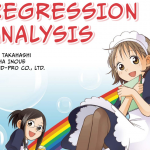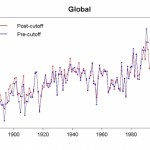statistics
Telling people that they are doing statistics wrong is a cottage industry that I usually want nothing to do with, for various reasons including the fact that the naysayers are often blindly repeating stuff they heard but do not understand. But, Alex Reinhart, in Statistics Done Wrong: The Woefully Complete Guide, does not do that, and this is a book that is worth reading for anyone who either generates or needs to interpret statistics.
Most of the 10 chapters that address specific technical problems with statistics, where they are misused or misinterpreted, are very helpful in guiding a…
Manga is the Japanese sounding but not used so much in Japan term for a form of cartooning art that has its roots from before World War II but that emerged in its common form during the post war Occupation period. Early used in political cartooning, Manga style drawing is now used for a wide range of expression, and has a place in illustrating a wide range of products, read by Japanese citizens of all sorts and ages. Outside of Japan, Manga is the starting point for the wildly popular Anime style of expression, which of course brings us to...
Pokeman go
But, we are not here to talk about…
Most scientists I know get a chuckle out of the Journal of Irreproducible Results (JIR), a humor journal that often parodies scientific papers. Back in the day, we used to chuckle at articles like "Any Eye for an Eye for an Arm and a Leg: Applied Dysfunctional Measurement" and "A Double Blind Efficacy Trial of Placebos, Extra Strength Placebos and Generic Placebos." (What saddens me is that this is basically what research into so-called “complementary and alternative medicine,” now more frequently referred to as “integrative medicine” boils down to.) Unfortunately, these days, reporting on…
I put Tove Jansson's Moomin character the Muddler, Sw. Rådd-djuret, into a presentation. It's about multivariate statistics for archaeologists, and I accompany the picture with the following quotation.
How could you forget about the Muddler when you launched the ship, Sniff said accusingly. Did he ever get his button collection back into order?
Oh yes, many times, said Moominpappa. He came up with new button systems all the time. Sorted them according to colour or size or shape or material, or according to how much he liked them.
Amazing, Sniff said dreamily.
--- Tove Jansson 1968, The…
In the latest issue of Significance, the journal of the Royal Statistical Society & American Statistical Association, economists Barry Reilly, Neil Rickman and Robert Witt take a look at the surprisingly mediocre returns that bank robbers can expect. The Fiscal Times has the story:
In the U.S., based on 2006 data, the average take from a bank heist was $4,330. In the U.K., it was much bigger: £20,331, based on 2007 data (or about $40,000 based on the exchange rates that year). A third of the robberies yielded nothing, meaning that the average take from a successful…
And I suspect he's done so willingly. Well, you know what they say about statistics and liars.
Here's the story. The Wall Street Journal and the Daily Mail independently published highly misleading and blatantly idiotic pieces on climate change. We've covered this extensively already over the last few days. Phil Plait, of the Bad Astronomy Blog on Discovermagazine.com, was one of numerous scientists to respond to those flaming examples of horrific bottom feeding journalism with the post "While temperatures rise, denialists reach lower." In that post, he presented a still-image from a…
There are two recent studies of gender disparities in science and technology (referred to by the faintly awful acronym "STEM") getting a lot of play over the last few days. As is often the case with social-science results, the data they have aren't quite the data you would really like to have, and I think it's worth poking at them a little, not to deny the validity of the results, but to point out the inherent limitations of the process.
The first is a study of lifetime earnings in various fields that includes this graph showing that women with a Ph.D. earn about the same amount as men with a…
When worked on the human microbiome, I regularly confronted a problem with the data. Species frequencies are almost never normally distributed ('the bell curve'), and if you want to use standard statistical techniques the data should be normally distributed. The second problem is that the data often have a lot of zero values. That is, if I look a bunch of gut samples from people (actually the data--the samples are VERY STINKY!), in many samples, a bacterial species* will be quite frequent (2-20%), but in other samples, it will be very rare (0.01%) or completely absent (i.e., 0%).
Often,…
A bunch of people I follow on social media were buzzing about this blog post yesterday, taking Jonah Lerher to task for "getting spun" in researching and writing this column in the Wall Street Journal about this paper on the "wisdom of crowds" effect. The effect in question is a staple of pop psychology these days, and claims that an aggregate of many guesses by people with little or no information will often turn out to be a very reasonable estimate of the true value. The new paper aims to show the influence of social effects, and in particular, that providing people with information about…
Nicholas Kristof has done some excellent reporting on the issues facing the developing world. But he is a case study in how reporting and analysis are not necessarily part of the same skill set. In Thursday's column, Kristof writes (italics mine):
When I was in college, I majored in political science. But if I were going through college today, I'd major in economics. It possesses a rigor that other fields in the social sciences don't -- and often greater relevance as well. That's why economists are shaping national debates about everything from health care to poverty, while political…
Last week, E.D. Kain took Megan McArdle to task for promoting the use of student testing as a means to evaluate teachers. This, to me, was the key point:
....nobody is arguing against tests as a way to measure outcomes. Anti-standardized-tests advocates are arguing against the way tests are being used, and the prioritization of tests. If you really, truly want to measure outcomes, you should not create a system that incentives teaching to a test. Teaching to a test not only narrows the curriculum, it means that teachers prepare students specifically for the test. This skews the outcomes of…
A little while back, Jonah Lehrer did a nice blog post about reasoning that used the famous study by Gilovich, Vallone and Tversky, The Hot Hand in Basketball (PDF link) as an example of a case where people don't want to believe scientific results. The researchers found absolutely no statistical evidence of "hot" shooting-- a player who had made his previous couple of shots was, if anything, slightly less likely to make the next one. Lehrer writes:
Why, then, do we believe in the hot hand? Confirmation bias is to blame. Once a player makes two shots in a row - an utterly unremarkable event…
For those of you who like interactive data, the American Human Development Project has a great website that drills down to the county level for education, health, and income data in the U.S. It also has all of the data in a spreadsheet, if you want to do your own analysis.
So wonk out!
Over at The Art of Science Learning, Peter Economy writes:
One of my great concerns for this country's future is the underperformance of our youth when it comes to achievement in math and science. In December 2010, the Organization for Economic Cooperation and Development (OECD) released the results of its 2009 Program for International Assessment (PISA) test, administered to thousands of 15-year-old students in 65 different countries around the world. The results were not good for the United States. In science, the U.S. ranked 23rd with a score of 502, well below Shanghai, China (575),…
It's NCAA tournament time, which is time for everybody to break out the moralizing stories about the pernicious aspects of college athletics that they've been sitting on since the football season ended. The Associated Press (via the New York Times) clocks in with a particularly discreditable entry, a story on a study of racial disparities in graduation rates in major college baskeball:
An annual report by the University of Central Florida's Institute for Diversity and Ethics in Sport found a 2 percent overall graduation rate increase to 66 percent for Division I players, but showed the rates…
By way of Observational Epidemiology, we find an interesting NY Times article by Michael Winerip describing a seventh grade teacher's experience with value added testing in New York City. I'll get to value added testing in a bit, but the story also highlights why we need more reporters who have backgrounds in math and science. Winerip:
On the surface the report seems straightforward. Ms. Isaacson's students had a prior proficiency score of 3.57. Her students were predicted to get a 3.69 -- based on the scores of comparable students around the city. Her students actually scored 3.63. So Ms.…
One of the supposed key innovations in educational 'reform' is the adoption of value added testing. Basically, students are tested at the start of the school year (or at the end of the previous year) and then at the end of the year. The improvement in scores is supposed to reflect the effect of the teacher on student learning*. I've discussed some of the methodological problems with value added testing before, and the Economic Policy Institute has a good overview of the subject. But what I want to discuss is a very serious flaw--what I would call fatal--with value added testing that stems…
He might be really good at designing operating systems (or not), but Bill Gates has a slight data problem. In an op-ed arguing that class size is unimportant and that teacher evaluation is crucial--and should be combined with merit pay, Gates makes this blunder (italics mine):
Perhaps the most expensive assumption embedded in school budgets - and one of the most unchallenged - is the view that reducing class size is the best way to improve student achievement. This belief has driven school budget increases for more than 50 years. U.S. schools have almost twice as many teachers per student as…
By way of Bob Somerby, we come across this Brookings Institution report by Tom Loveless, "How Well Are American Students Learning?" There's a lot in the report, especially since it's really three studies rolled into one, but part of section I, which debunks the notion that Finland has the best educational system in the world highlights the intersection of educational goals, curriculum, and testing. Loveless writes (p. 10):
But by 1999, Finland slipped to only a little above average in TIMSS (z-score of 0.06), ranking fifth of the original twelve countries and fourteenth of all countries…
When I read articles like this and this, it seems that educational 'reformers' are dwelling in a world utterly divorced from reality. If teachers unions and their 'sweetheart deals' are the problem, then why does Massachusetts excel? The teachers unions are very strong, and teachers are well compensated. For that matter, if teachers are so incredibly important, should we then conclude that Massachusetts' teachers are far 'better' than Alabama's?
It seems the reformers confuse bad teachers (which do exist in terms of motivation or personality) with poor teaching. The latter stems from poor…




